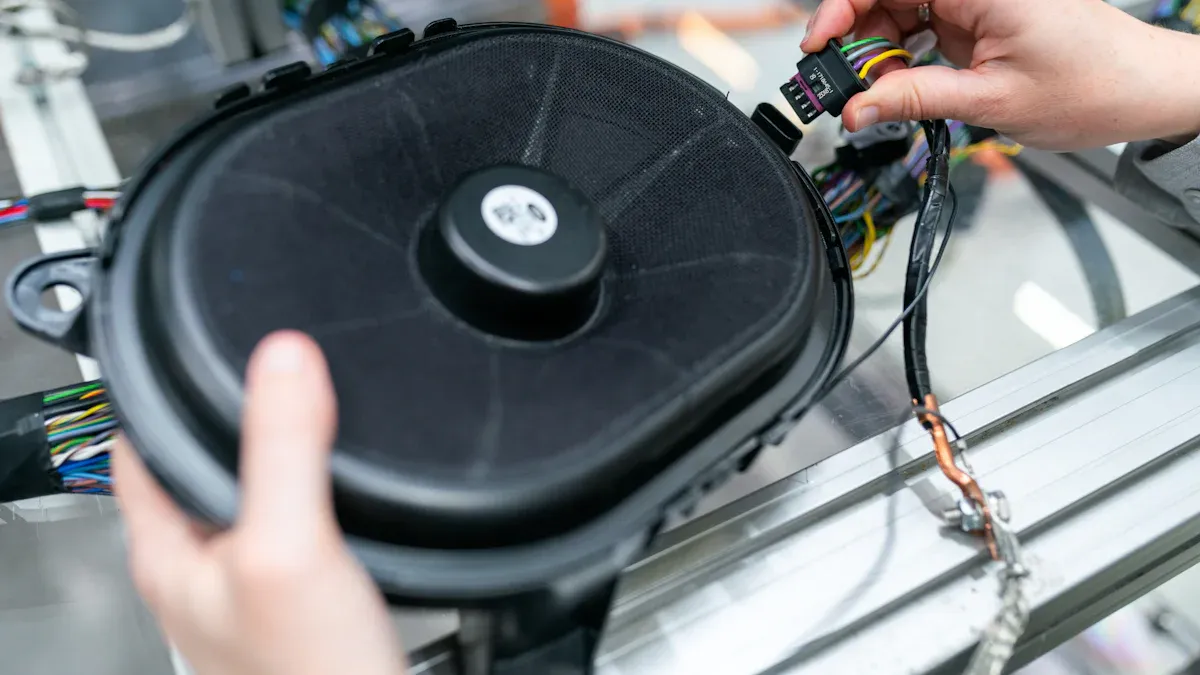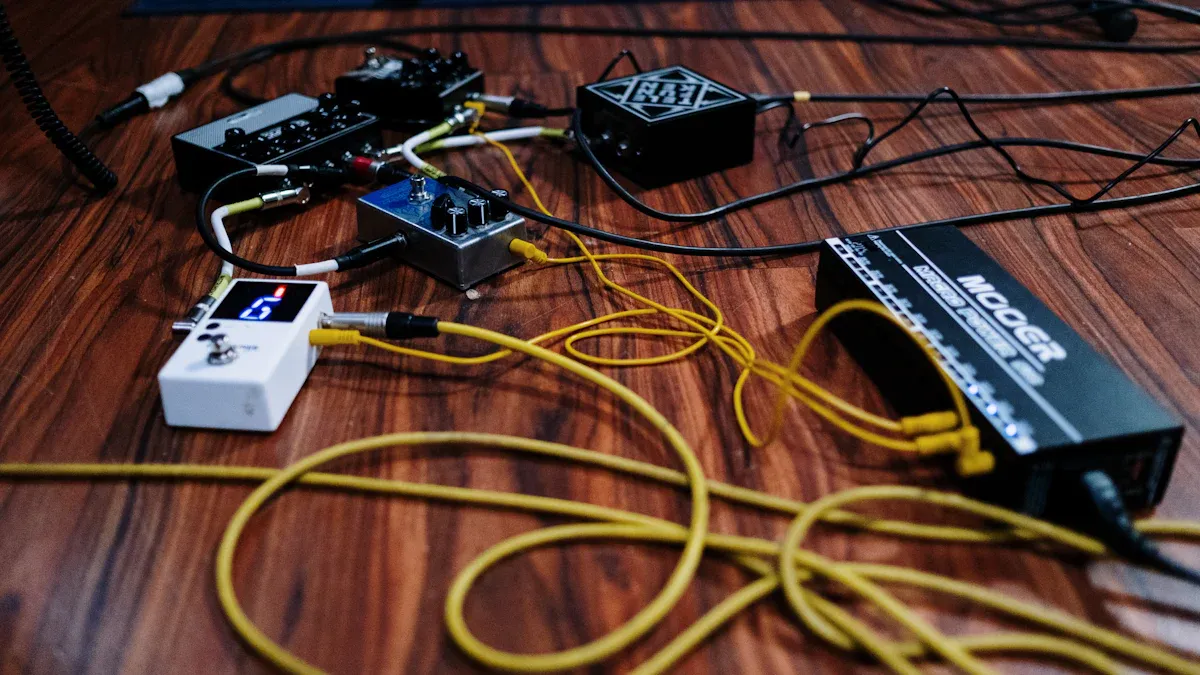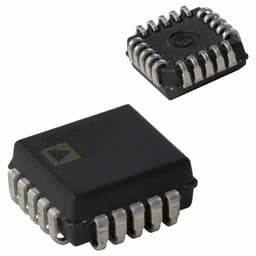
Anyone can make a car’s sound system better by learning to install line output converter equipment. This process gives you better sound without changing the car’s radio. A line output converter lets you add amplifiers and subwoofers to your car easily. Many beginners pick a line output converter because it helps avoid expensive mistakes and keeps the car’s wiring safe.
Tip: Using a line output converter lets you keep the original car stereo and makes the sound better.
Key Takeaways
-
Always take off the car battery before you start. This keeps you and the car safe.
-
Use the right tools like wire strippers and crimp connectors. Use electrical tape to make sure everything is safe.
-
Find the correct speaker wires and connect to them carefully. Do not cut the wires all the way. This keeps the car’s wiring safe.
-
Make sure all wire connections are tight. Keep the cables neat so they do not get damaged. This helps the sound stay good.
-
Test the system after you finish. Check if the sound is clear and the amplifier has power. Turn up the gain slowly so the sound does not get messed up.
Tools and Materials

Essential Tools
You need the right tools to install a line output converter. The right tools help you work safely and quickly.
-
Wire stripper: This tool takes off the plastic from wires. It helps you make good wire connections.
-
Crimp connectors or soldering iron: Crimp connectors let you join wires fast. A soldering iron makes a strong wire connection.
-
Screwdriver set: You use screwdrivers to open panels and hold wires in place.
-
Panel removal tools: These tools help you take off panels without breaking them.
-
Multimeter (optional): A multimeter checks if the line output converter works right.
Note: The right tools stop you from hurting the car’s wires and help you make good connections.
Required Materials
You also need the right materials to do the job well.
-
Line Output Converter (LOC): This device changes speaker signals to RCA signals. You need it to add new amplifiers or subwoofers.
-
RCA cables: These cables send sound from the LOC to the amplifier. They have a cover to block noise.
-
Electrical tape or heat shrink tubing: These keep wire connections safe and covered.
-
Zip ties: Zip ties help keep wires neat and stop them from getting mixed up.
Optional Items
Some things are not needed but can help you a lot.
-
Multimeter: A multimeter can help you check wires and fix problems.
-
Wire labels: Labels help you know which wire is which for later.
-
Extra fuses: Extra fuses are good to have if one breaks while you work.
Having all these tools and materials ready makes the job easier and safer. Each thing helps protect your car and makes your sound system better.
Preparation
Disconnect Battery
You must be safe when working with a car’s wires. Always disconnect the negative battery terminal before you start. This stops power from moving through the wires. It helps keep you and the car’s electronics safe from harm.
-
Open the hood and find the battery.
-
Find the negative terminal. It has a black cable and a minus sign.
-
Use a wrench to loosen the nut on the negative terminal.
-
Take off the cable and put it aside. Make sure it does not touch any metal.
Tip: Always take off the negative terminal first. This helps stop sparks or shocks from happening.
Doing this step keeps the car safe while you install a line output converter. It also helps protect the car’s electronic parts from damage.
Locate Speaker Wires
After you disconnect the battery, you need to find the factory speaker wires. These wires send sound from the car’s radio to the speakers. The line output converter needs to connect to these wires to get the sound.
-
Take off the trim panels or radio unit with panel removal tools.
-
Look behind the radio or near the speakers for wire bundles.
-
Use a wiring diagram for your car to find the right speaker wires. You can find these diagrams online or in the car’s manual.
-
Check the wire colors and labels to make sure they match the diagram.
Note: Do not cut the wires all the way. Strip a small part of the insulation to connect new wires. This keeps the factory wires safe and makes it easy to go back to the old setup if you want.
If you find and handle the speaker wires carefully, the installation will go smoothly. This step gets the car ready for connecting the line output converter next.
Install Line Output Converter
Connect to Speaker Wires
Start by hooking up the line output converter to the car’s speaker wires. Most converters have colored wires. These colors show which wires are positive and negative. Use a wiring diagram to find the right wires. Strip about half an inch of plastic off each speaker wire. Do not cut the wire all the way through. This keeps the car’s wiring safe.
Connect the positive wire from the converter to the positive speaker wire. Do the same with the negative wires. Twist the wires together so they stay tight. Some converters have terminals for the wires. You can put the wires in and tighten them with a screwdriver. This makes the job easier and safer.
Tip: Always check the wire colors before you connect anything. If you mix up the wires, the sound may be bad or the equipment could break.
Secure Connections
After you connect the wires, make sure each one is secure. Use crimp connectors or solder the wires to hold them together. Cover each connection with electrical tape or heat shrink tubing. This keeps the wires safe from short circuits.
Use zip ties to keep the wires neat and tidy. Make sure the wires do not touch moving parts or sharp edges. Neat wires help stop problems later and make the system look nice.
Note: Keeping the car’s wiring safe is very important. Good connections help the line output converter work well and protect the car’s audio system.
RCA to Amplifier
When the speaker wires are connected, plug the RCA cables into the converter’s output jacks. Run the RCA cables to the amplifier. Do not run RCA cables next to power wires. This helps stop noise in the sound.
If your converter has a gain knob, turn it to the lowest setting first. Turn on the system and slowly turn up the gain until the sound is clear. Do not turn the gain up too high. Too much gain can make the sound bad or hurt the speakers.
Pro Tip: Use good RCA cables for the best sound. Hold the cables in place with zip ties so they do not move.
If you follow these steps, you can install a line output converter safely. This helps you make your car’s sound system better without hurting the original wires.
Testing
Reconnect Battery
After finishing all wiring, reconnect the negative battery terminal. Place the cable back on the battery post. Tighten the nut with a wrench. Make sure the cable sits firmly on the terminal. This step restores power to the car’s electrical system. Always check that no tools or wires remain near the battery before closing the hood.
Safety Tip: Wear gloves when working with the battery. Batteries can leak acid or spark if handled carelessly.
System Test
Turn on the car’s ignition. Power up the radio and amplifier. Play music at a low volume first. Listen for clear sound from the speakers and subwoofer. Check if the new amplifier turns on with the radio. Walk around the car and listen for any buzzing or humming. Use a simple checklist:
-
Does the amplifier power light turn on?
-
Can you hear sound from all speakers?
-
Is the sound clear, without distortion?
-
Do the controls on the amplifier work?
If the line output converter has a gain knob, adjust it slowly. Stop turning when the sound reaches a good level. Avoid turning the gain too high. High gain can cause distortion or damage speakers.
Troubleshooting
If the system does not work, check all connections. Make sure the wires match the correct colors. Look for loose or exposed wires. If there is no sound, test the RCA cables and speaker wires. Sometimes, the amplifier may not turn on. Check the fuse and power wire. If the sound is distorted, lower the gain or check for crossed wires.
Note: Many problems come from simple mistakes. Double-check each step before seeking help.
A careful test ensures the new audio setup works well and delivers better sound in the car.
If you follow all the steps, you can install a line output converter easily. Always check your work and think about safety first. Being careful helps you avoid mistakes and keeps the car’s audio safe. Most people get better sound after doing this upgrade. If you still have problems, ask a professional for help.
FAQ
What does a line output converter do?
A line output converter takes speaker signals and changes them to RCA signals. This lets you hook up an amplifier or subwoofer to your car’s stereo. You can get better sound without buying a new radio.
Can anyone install a line output converter?
Most people can put in a line output converter if they have some tools and time. The steps are easy to follow. Beginners should read the instructions and check each wire for safety.
Will installing a line output converter damage the car’s wiring?
If you install it the right way, the car’s wires stay safe. Use wire strippers and connectors so you do not cut wires all the way. Always cover the wires with tape or heat shrink tubing to stop shorts.
Why does the sound have distortion after installation?
Distortion can happen if the wires are not hooked up right or if the gain is too high. Check every wire and turn down the gain on the converter. Using good RCA cables and tight connections helps stop noise.
Written by Jack Elliott from AIChipLink.
AIChipLink, one of the fastest-growing global independent electronic components distributors in the world, offers millions of products from thousands of manufacturers, and many of our in-stock parts is available to ship same day.
We mainly source and distribute integrated circuit (IC) products of brands such as Broadcom, Microchip, Texas Instruments, Infineon, NXP, Analog Devices, Qualcomm, Intel, etc., which are widely used in communication & network, telecom, industrial control, new energy and automotive electronics.
Empowered by AI, Linked to the Future. Get started on AIChipLink.com and submit your RFQ online today!













